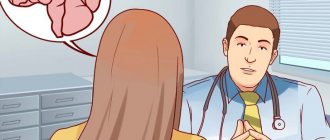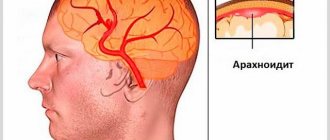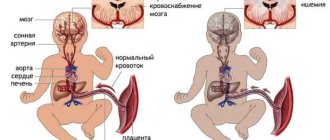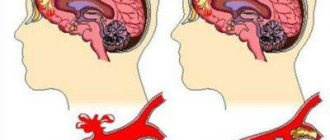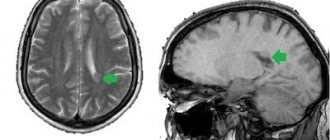Reasons for appearance
A cerebral pseudocyst in newborns is a cavity in the medulla that contains fluid. Most often, the cyst is filled with cerebrospinal fluid. Brain pseudocysts in newborns appear as a result of exposure to the following factors:
- lack of oxygen during labor;
- hematomas in the head;
- lack of nutrients, which provoked problems with blood supply in the cerebral vessels;
- birth trauma newborn.
The most dangerous neoplasm is recognized as a subepindeminal tumor - it usually occurs as a result of trauma to the baby during labor. Sometimes its appearance is caused by complications during intrauterine development, but such a neoplasm is never genetically determined. It mainly appears during the period of growth in the mother's body, but its aggravation factors arise at birth.
There are no special medical techniques for treating pseudocysts in the head of a newborn. Only general symptomatic therapy is carried out to restore the baby’s cerebral circulation. All this time, the child needs to be observed by a neurologist.
During the course of supportive measures, the neoplasm usually resolves, and if this does not happen, it is classified as true and the baby is given an appropriate diagnosis. Doctors monitor the little patient all the time and register him for the disease.
The detection of a cyst in newborns, whether false or true, does not affect further development . During the process of human growth, the defect does not provoke negative manifestations, and deterioration of the condition is recorded on average in 2-3% of cases.
Why is a pseudocyst dangerous?
p, blockquote 10,0,0,0,0 —>
p, blockquote 11,0,0,0,0 —>
In most infants, pseudocysts and true cysts of the brain do not manifest themselves in any way and do not interfere with further development. A cyst is dangerous only if it grows rapidly and compresses adjacent brain tissue. Such cases occur in 1-5% of patients. The child may then develop the following symptoms:
p, blockquote 12,0,0,0,0 —>
- Convulsive states.
- Headache attacks.
- Sleep disturbance.
- Deterioration of vision and hearing.
- Hormonal imbalance.
- Tremor of the limbs.
Diagnostics
Ultrasound is recognized as the most accurate and safe diagnostic method for detecting pseudocysts in the head of newborns. Ultrasound diagnostics is performed for all patients who suffered hypoxia during childbirth, were injured, received a low Apgar score, or doctors discovered behavioral defects in the baby. Indications for diagnosis include sleep problems, moodiness, and frequent mood swings.
If a pseudocyst is once detected in a newborn, a specialist neurologist will monitor the neoplasm over time, since it is extremely important to monitor the increase in the size of the pseudocyst in the newborn.
The child’s secondary consultation mainly has one goal – to find out the dynamics of the disease. If the child’s education remains the same or grows, drug support is required. The objectives of conservative care are to eliminate the worsening of the situation , for example, the appearance of migraines and convulsions. As the baby grows, ultrasound diagnostics are replaced by magnetic resonance imaging - this way the head is better visualized.
Traditional methods
To improve the condition of a child with large cystic formations, together with drug treatment, you can resort to traditional medicine. The most popular recipes are:
- Hawthorn decoction, taken orally, will strengthen the nervous system and improve the sleep of the little patient.
- Cinquefoil, horsetail, violet, capsicum will reduce intracranial pressure.
- Hemlock has an excellent absorbent effect.
- Baths with herbal infusions have a calming effect.
To prepare a healthy decoction with a calming effect, you can take raspberry leaves, calamus root, yarrow, chamomile, and licorice root in equal proportions. 2 tablespoons of crushed raw materials are infused in 0.5 liters of boiling water for 7-8 hours. The finished strained broth is added to the bath and the baby is bathed.
Subependymal pseudocyst of the brain, which is found in newborns, is considered a benign tumor and requires regular monitoring. Basically, the problem goes away over time, leaving no negative consequences. The main thing is to monitor the course of the pathology and follow the doctor’s recommendations.
Features of differentiation
Since it is difficult to distinguish a cerebral pseudocyst in newborns from a true tumor, doctors carefully examine each tumor in order to identify the most characteristic common signs for one and the other disease.
Signs of a pseudocyst:
- typical localization is located in the ventricle of the brain. In rare cases, pseudocysts in the head of newborns can be found between the caudate horn and the center responsible for visual function. All other localizations indicate the presence of a true cyst, since it is located in other parts;
- the origin of the cyst - it is always an acquired defect, is not inherited and is not congenital. If a baby is diagnosed with a multi-chamber pseudocyst of the brain, then it usually indicates a ruptured vessel and hemorrhage, and with oxygen starvation during childbirth, a tumor appears in the ventricles of the medulla.
A more accurate diagnosis can only be made after an ultrasound examination.
Difference between a cerebral cyst and a pseudocyst
p, blockquote 18,0,0,0,0 —>
False brain cysts differ from true ones according to the following criteria:
p, blockquote 19,0,0,0,0 —>
- Localization. Most often, the pseudocyst is located between the subcortical nuclei of the base of the brain, next to the lateral ventricles or in the cerebral hemispheres.
- Genesis The causes of the disease are acquired or secondary.
Only instrumental diagnostics helps to establish an accurate diagnosis. If a neonatologist recommends undergoing an examination, you cannot refuse it. It should be remembered that timely detection of an anomaly allows you to avoid serious consequences.
p, blockquote 20,0,0,0,0 —>
Therapy
It is not recommended to treat the tumor before the first year of life. At this time, the baby is actively monitored. In most cases, by the end of the infant period, cerebral pseudocysts are not detected in newborns.
In order to improve cerebral circulation, a neurologist will recommend taking Actovegin. Diacarb will be useful for reducing pressure on the medulla, but it should be taken strictly according to indications so as not to lead to dehydration.
In order to improve the baby's health, manual therapy is indicated - it promotes the harmonious and proper development of the neuro-reflex system.
If a cerebral pseudocyst in a newborn cannot be cured, it means that the baby has a true formation. Then the doctor will prescribe another examination and will find out the cause of the cyst and its effect on the functioning of the nervous system. If necessary, anticonvulsants are prescribed. In this case, there is no need to worry - the outcome for patients is positive.
Treatment
The course of pathology observed in a newborn child should be monitored by a pediatric neurologist. The following techniques can be used during therapy.
Medicines
As a rule, doctors prescribe a number of drugs to children, the action of which is aimed at improving blood circulation in the brain, and also prescribe antihypoxants:
- Mexidol;
- Cytoflavin;
- Vitamins belonging to group B;
- Mildralex.
If hyperactivity is observed, the use of drugs such as:
- Glycine;
- Pantocalcin, as well as Pantogam.
To strengthen the musculoskeletal system, you should attend massage sessions, but only if they are recommended by your doctor.
If the false cyst was not subject to resorption during the first year of the child’s existence, and it increases in size, surgery will be required. Removal of the formation is carried out through craniotomy using endoscopy and shunting techniques.
Surgery
Endoscopic surgical procedures are by far the best ways to treat tumors in children. But such operations are not carried out in all cases. If your baby has been diagnosed with a cyst of the septum pellucida developing in the brain area, then this technique is perfect for treatment. The treatment is not accompanied by complications and avoids excessive trauma to the small patient.
The recovery period after surgery to remove a cyst is different for each case, and depends on the general well-being and state of health of the child.
Folk remedies
To improve the well-being of children with large cystic formations in the brain, in addition to the use of medications, folk remedies can also be used. The most effective are the following recipes:
- a decoction made from hawthorn fruits. The liquid is taken internally to strengthen the nervous system. This product helps improve baby's sleep;
- horsetail, cinquefoil, as well as capitol and violet are distinguished by their ability to lower intracranial pressure;
- Hemlock is endowed with excellent absorbent properties;
- herbal infusions for taking soothing baths.
To prepare a decoction that has a calming effect, you will need to take raspberry leaves, yarrow, as well as chamomile, licorice rhizome and calamus. The components are used in equal proportions and mixed. Composition in the amount of 2 tbsp. should be placed in a container, pour boiling water (0.5 l) and leave for 8 hours. After this, the liquid is filtered and added to the baby’s bathtub.
Before using traditional medicine in the fight against pseudocyst, you should consult with your doctor.

